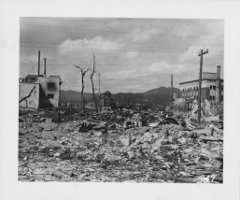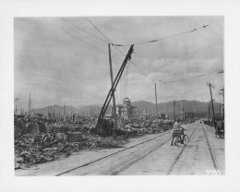The First Atomic Bomb: 1/40th of a second after detonation at the Trinity site in New Mexico.
Credit: Association of Los Alamos Scientists. Records, asas-03080-002, asas-03080-003, asas-03080-004, asas-03080-005, Special Collections Center, University of Chicago Library
Instead, at age 17 I enrolled at Cornell University in New York. For two semesters I studied electrical engineering and some physics. Then, despite having grades like a nerd and before the Navy could get a hold of me to put me into the college program to become an “officer and a gentleman,” I joined the Merchant Marine. I had had enough of privilege growing up, and I wanted to contribute to the war effort.
One day in the summer of 1945, aboard a sea-going tug pulling a giant dry-dock out to Enewetak Atoll on the rolling waters of the Pacific, I heard the voice of the ship’s captain booming over the public address system. The United States had dropped an atomic bomb over Hiroshima and Nagasaki, Japan, and the war was over. Immediately the captain summoned Sparks (that was my nickname as the ship's electrician) to report to the mess hall and explain what this bomb business was all about. I hardly knew the ship's captain, or any of the deck officers, for that matter, but if you're a smart-aleck kid, you're recognized from day one. What I had to say about fusion and fission and how a nuclear bomb works was classified information then. Some of it still is.
Center of Hiroshima: The center of Hiroshima after the dropping of the atomic bomb on August 6, 1945.The bomb destroyed approximately three-fourths of the city and killed an estimated 80,000 people immediately, with thousands more dying later from injuries and radiation poisoning. Records lead us to believe that the bomb touched down approximately halfway between the two smokestacks in this image.
Credit: Association of Los Alamos Scientists. Records, asas-03081-004, Special Collections Center, University of Chicago Library
Main Street in Hiroshima: The center of Hiroshima after the dropping of the atomic bomb on August 6, 1945. The street indicated in this photograph is approximately one half (0.5) mile from the location where the bomb was detonated indicating the extent of the devastation to the city’s buildings and roads.
Credit: Association of Los Alamos Scientists. Records, asas-03081-002, Special Collections Center, University of Chicago Library



